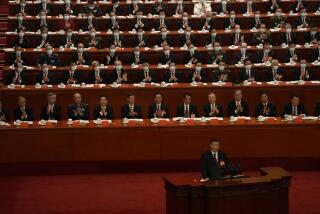<i> Perestroika </i> Gets Headlines, but <i> GaiGe </i> Has the Get-Up-and-Go
Actions do not always speak louder than words. While the media have devoted meticulous attention to each twist and turn in Soviet pronouncements on “restructuring,” there has been relative neglect of the truly significant actions and experiments undertaken by the Chinese to bring about genuine reform.
As a result of this contrast, perestroika has become a multilingual synonym for systemic restructuring, while its Chinese counterpart, gai ge , is virtually unknown outside China.
While the Soviets have spoken louder and more often about reform, the Chinese are simply and pragmatically doing it. It remains uncertain whether and to what extent the Chinese will succeed or, if they do, how long success will last. If it does last, it’s also uncertain what the effect on the communist system will be. But at least the efforts are tangible and visible.
When the Soviet Union was holding its Communist Party Conference this summer, with 5,000 delegates and 250 speakers providing high theater in Moscow, I was in Beijing doing consulting work on one aspect of China’s reform. At the time, both the Western and Chinese media were filled with details about the Moscow conference: Mikhail S. Gorbachev’s proposalsto place more executive power in the hands of government while reducing that of the party; to shift party activity from micromanaging the economy to establishing policy (as though policy and execution can be readily separated), and to consider whether, as part of this realignment, responsibility for defense and foreign policy should be lodged with the government’s chief executive, rather than the Politburo. (Now that Gorbachev has assumed the position of president as well as party general secretary, the ironic result of this “reform” has been to concentrate more power in one man’s hands than at any time since Josef Stalin.)
Although the party conference provided one more indication of the remarkable change in the Soviet atmosphere--the importance of glasnost should not be minimized--the plain fact is that not much in the way of genuine system transformation has occurred in the Soviet Union. While words have been plentiful, actions have been quite limited.
In contrast to the rhetoric in Moscow, what has been under way in Beijing is much more significant and fundamental, as well as much less reported and understood outside China. For example, the Chinese in April established Hainan Island as China’s fifth and most special of its Special Economic Zones. Along with the other four zones, the new province of Hainan isexplicitly intended to be an experiment in creating an economic environment that would borrow from the development experience of Hong Kong, South Korea and Taiwan. The Hainan innovations include a loosening of the Beijing bureaucracy’s tight control over the provincial Hainan government, and the providing of 70-year land-lease arrangements and tax advantages to encourage foreign investment.
In the Special Economic Zones, as well as in such trade-oriented coastal provinces as Guangdong, several thousand joint ventures, partly financed with foreign capital, are already in operation (only a few dozen have been started in the Soviet Union). In China, fundamental market-oriented policies are actively discussed at the highest levels. These include policies to relate prices to economic costs, to gear wages and salaries to productivity rather than seniority, and to acknowledge that savings, accumulation, profits and property rights are essential elements in system reform. The issues that arise in China relate less to the desirability of moving in these directions than to their timing, sequence and the extent of the remaining non-market sector.
Of course, gai ge has been under way for about nine years, perestroika for less than four. Nevertheless, over a roughly comparable span, genuine reform has moved much further in China than it has in the Soviet Union. By 1984 China had abolished the communes, launched the “responsibility system” in Sichuan Province that produced a surge in small-holder agricultural production and reportedly increased individual commercial enterprises tenfold. Most of the corresponding stirrings in the Soviet Union have been in the realm of pronouncements, proposals and decrees.
It obviously remains uncertain how either Deng Xiaoping’s or Gorbachev’s reform efforts will work out in the long run. Opposition exists in both countries, but even this provides an instructive contrast. In China, the recently reported opposition to gai ge relates to the short-term price effects of market-oriented actions. In the Soviet Union, critics are of two quite different types: those who criticize the absence of action, and those who fear the consequences if it occurs.
In any event, there’s little question about which reform effort has the better chance of moving forward. Perestroika in the Soviet Union is still a pallid counterpart to gai ge in China. Moscow may be where the publicity is. Beijing is where the action is.
More to Read
Sign up for Essential California
The most important California stories and recommendations in your inbox every morning.
You may occasionally receive promotional content from the Los Angeles Times.









